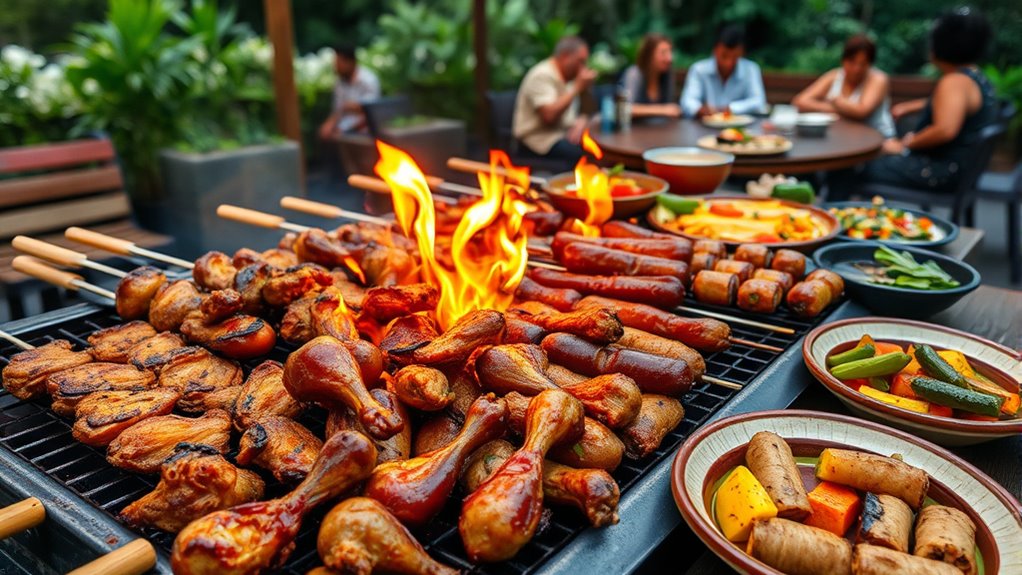To master global grilling, start by using marinades that reflect each cuisine’s signature flavors—think soy, garlic, and sesame for Korean BBQ or olive oil, lemon, and herbs for Italian dishes. Use the right accessories like skewers, grill pans, or portable grills to achieve authentic results. Controlling temperature and avoiding overcooking are key. Keep exploring these techniques and tools to elevate your grilling game across diverse cuisines; more tips await you.
Key Takeaways
- Use specific marinades like soy garlic for Korean BBQ and lemon-herb for Italian to enhance authentic flavors.
- Choose appropriate grilling accessories such as tabletop grills for Korean BBQ or cast-iron pans for Italian dishes.
- Adapt techniques like marinating and temperature control to preserve signature flavors of each cuisine.
- Incorporate tools like skewers for Middle Eastern kebabs or basting brushes for flavor infusion.
- Combining global marinade techniques and accessories elevates the authenticity and diversity of grilled dishes.

Grilling isn’t just about backyard barbecues; it’s a versatile technique that brings out authentic flavors from around the world. When you explore global cuisines, you realize that the art of grilling involves more than just cooking over an open flame. It’s about mastering marinade techniques that infuse your ingredients with bold, complex flavors. For example, Korean BBQ relies heavily on marinades made with soy sauce, garlic, sesame oil, and a touch of sugar, which tenderize and flavor the meat deeply. To achieve this, you might use a basting brush or marinating bag, both of which are essential grilling accessories that make the process easier and more effective. Properly marinated meats absorb flavors better and stay juicy, giving your dishes an authentic touch.
Master global grilling with marinades and essential accessories for authentic, flavorful results.
Different cuisines also call for specific grilling accessories that enhance the experience. For Korean BBQ, a portable tabletop grill or a high-quality grill pan allows you to cook thin slices of beef or pork evenly, mimicking restaurant-style results at home. For Italian grilling, you might prefer a cast-iron grill pan or a traditional barbecue grill to achieve those perfect grill marks on vegetables, seafood, or steaks. These accessories help you control temperatures and get those desirable charred edges that define Italian outdoor cooking. Similarly, for Middle Eastern kebabs, skewers are a must-have, allowing you to layer marinated meat and vegetables in a way that promotes even cooking and flavor infusion.
Exploring these cuisines means adapting your grilling techniques to match their signature flavors. For instance, Mediterranean grilling often involves marinating fish or chicken in lemon, herbs, and olive oil, which requires a gentle touch to prevent overpowering the delicate flavors. Your grilling accessories—like tongs, heat-resistant gloves, and a good thermometer—become essential tools in managing precise cooking times and temperatures. These tools help you avoid overcooking or undercooking, ensuring your dishes stay true to their authentic taste profiles.
As you venture into global grilling, remember that the right marinade techniques and accessories are your best allies. They allow you to replicate traditional flavors and techniques while also experimenting with new combinations. Whether it’s a smoky Italian sausage, a spicy Korean galbi, or a fragrant Middle Eastern kebab, mastering these essentials elevates your grilling game and transports your taste buds around the world. So, invest in good quality tools, learn the marinade secrets of each cuisine, and enjoy the journey of creating international grilled masterpieces right in your backyard.
Frequently Asked Questions
What Types of Charcoal Are Best for International Grilling Styles?
You should choose natural hardwood charcoal for international grilling styles because it offers a richer charcoal flavor and consistent fuel performance. Lump charcoal provides a clean, smoky taste ideal for Korean BBQ and Italian dishes, while briquettes deliver steady heat for longer cooking times. Both types guarantee reliable fuel consistency, allowing you to achieve authentic flavors and perfect grilling results across diverse cuisines.
How Do Spice Levels Vary Across Different Global Barbecue Cuisines?
Imagine a flame dancing wildly, reflecting regional heat preferences across global cuisines. Spice level variations stretch from mild Italian marinades to fiery Korean gochujang, each tailored to local tastes. You’ll find that some cultures favor a gentle warmth, while others crave intense heat that ignites your senses. Understanding these regional heat preferences helps you master the art of balancing flavors, ensuring your grilled creations perfectly match the authentic spicy spirit of each cuisine.
Are There Specific Tools Unique to Certain Regional Grilling Techniques?
Yes, specific regional grilling techniques often require unique grill tools and accessories. For example, Korean BBQ uses specialized tongs and metal grills, while Italian grilling might involve long-handled brushes and skewers. These regional grilling accessories amplify authenticity and efficiency, helping you achieve traditional flavors. Investing in these unique tools guarantees you can replicate authentic techniques, making your grilling experience more genuine and enjoyable across different cuisines.
How Can I Adapt Traditional Recipes for Different Cultural Tastes?
You can adapt traditional recipes for different cultural tastes through fusion cooking by blending flavors and techniques. Experiment with ingredient substitutions to match local preferences, like using soy sauce instead of Worcestershire or swapping in regional herbs. Adjust seasonings and cooking styles to suit the palate. This approach creates a unique, flavorful experience that respects the original dish while appealing to diverse tastes.
What Are Common Side Dishes Paired With International Grilled Mains?
You can pair international grilled mains with fusion flavors and seasonal accompaniments to enhance your meal. For Korean BBQ, try kimchi and pickled vegetables; for Italian, serve grilled vegetables and fresh basil. Incorporate seasonal fruits or salads to add variety and freshness. These side dishes complement the main course, creating a balanced, flavorful experience. Adjust your choices based on the cuisine to keep your meal exciting and authentic.
Conclusion
So, next time you fire up that grill, remember you’re not just cooking—you’re summoning the flavors of the world’s most legendary cuisines. With every sizzle, you could be transforming your backyard into a bustling Korean BBQ joint, an Italian trattoria, or a Moroccan market. Your grill isn’t just a tool; it’s a passport to culinary adventure, capable of making even the simplest meal feel like a feast fit for royalty. So go ahead, make every bite an epic journey!









